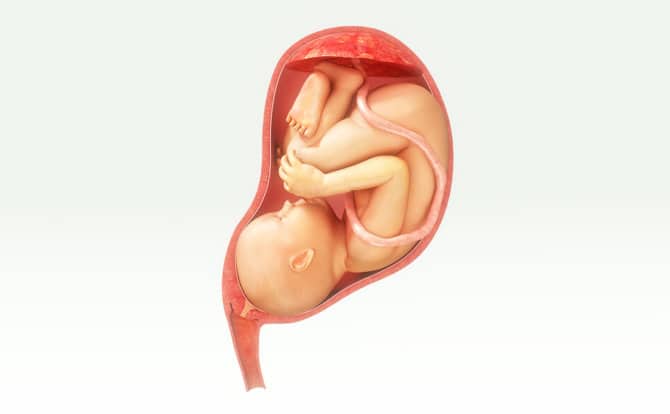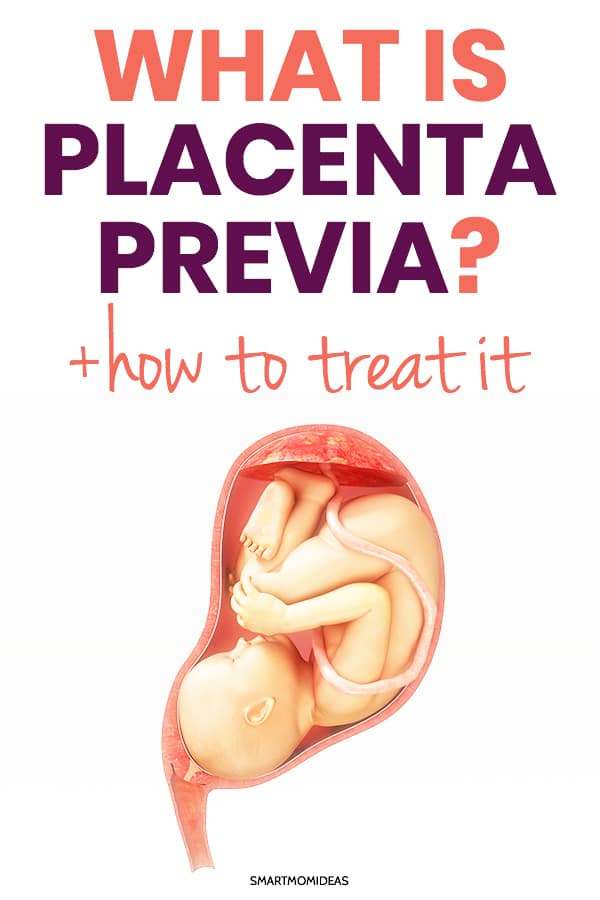Learn what placenta previa is, its symptoms, and how you can avoid further complications during your pregnancy, labor, and delivery.

Expecting mamas often have thoughts of concern and even worry playing in the background throughout pregnancy. As we experience certain changes in our bodies, it can be hard to tell what’s normal.
And if it’s not normal, we’re left to question just how serious the problem is.
It’s easy to develop fear around not knowing the medical term your doctor just diagnosed you with.
Let go of your fear and anxiety by learning what placenta previa is and how it affects you and your baby.
What is Placenta Previa?

Definition: Placenta previa is when the placenta is covering all or part of the mother’s cervix.
Basically, the placenta is obstructing the path where your baby will come out during a vaginal delivery.
This condition affects about 1 in every 200 women during their third trimester but doesn’t always begin in the third trimester.
There are actually three types of placenta previa, all in which the placenta is covering a different part of the cervix.
3 Types of Placenta Previa
- Complete Previa: The cervical opening is completely covered
- Partial Previa: A fraction of the cervix is covered by the placenta
- Marginal Previa: Extends just to the edge of the cervix
Complete or partial previas require a cesarean to deliver baby while marginal previas can sometimes be delivered vaginally. The reason for this is because as the cervix dilates, the placenta can bleed severely.
For many women diagnosed with this early on in pregnancy, it resolves on its own (as their uterus grows). The more the placenta covers the uterus and the further along a woman is in her pregnancy, it is less likely to resolve on its own.
And thus, will be more likely to require the mother to have a cesarean.
How Placenta Previa Starts
Unfortunately, the exact cause of placenta previa is unknown.
How Placenta Previa is Diagnosed
Placenta previa is usually diagnosed by ultrasound either during the prenatal visit during the second trimester or after a large amount of bleeding has occurred.
Symptoms of Placenta Previa

Here are a few signs that may indicate placenta previa. Keep in mind that if any of these symptoms are present, it’s best to see your doctor first to confirm.
Some of these symptoms can be indicators of another medical condition, so be sure to speak with your doctor.
Don’t wait until you’re due for your next prenatal appointment to notify your doctor. Schedule your appointment for as soon as possible.
Most clinics have a nurse on call for emergencies 24/7.
If you call during business hours, make sure to notify the receptionist that your need to see your doctor is urgent. Make sure to let them know the symptoms you’re having and provide as many details as possible.
These are the most common symptoms of placenta previa:
- Severe bleeding during pregnancy and delivery (life-threatening).
- Bright red vaginal bleeding is the main symptom during the 2nd half of pregnancy
- Contractions (not braxton hicks)
- Breech baby
- Uterus is measuring large
If you are experiencing severe bleeding or contractions, seek emergency medical attention.
If you’re bleeding vaginally, it’s best to wear some sort of pad or panty liner to catch the blood. That way you can see how much blood you’re losing and in what period of time. It also makes it easier to show your doctor so they can make an accurate assessment of your condition.
Placenta Previa Concerns
This condition should be taken seriously as there are steps you can take to reduce the risk for certain outcomes. Here are the main concerns related to placenta previa:
- Preterm birth
- Birth defects
- Slowed fetal growth
- Bleeding (or hemorrhage)
Whose at Higher Risk?
Your risk for placenta previa is higher if you fit into any of the following categories. However, this does not mean that you’re guaranteed to have this condition either. It just means your risk is slightly higher, mama.
- Women who have had a baby before
- Previously diagnosed with placenta previa
- Are carrying more than one fetus
- Smoke
- Use cocaine
- 35 or older
- Races outside of caucasian
- Have uterus scars such as from previous cesarean, uterine fibroid removal, and curettage
Placenta Previa Treatment

Once you’ve been diagnosed with placenta previa, your doctor will work with you to ensure you don’t face any further complications.
Since it’s not a condition that can be treated (in the sense of adjusting the placenta to the right place), treatment involves taking some (or all) the following steps to ensure the condition does not worsen.
- Avoid any activities that may cause contractions (sex, inserting tampons, douching, running, squatting, jumping)
- Bed rest
- Frequent hospital visits for monitoring
- Avoid pelvic exams
- Limit traveling
Your doctor will monitor your condition and advise you throughout your pregnancy to help make sure you do not have a preterm birth by cesarean.
Understanding Placenta Previa
Whether you’re experiencing symptoms that may be caused by placenta previa or the diagnosis has already been confirmed, you now have a little more clarity about what it is and what you can do throughout your pregnancy to help the situation.
Just remember to seek the advise of a medical professional (your doctor) so you can receive specialized care and instructions for the best possible outcome, mama.
If you’ve been diagnosed with this condition in your first trimester, don’t give yourself over to fear! Hard as it may be, this really is one of those situations that require your patience. Who knows, your placenta my just end up resolving on its own!
Hang in there, mama!
Focus on doing the best that you can do.
Keep your mind on how great it’s going to be when you have your little one in your arms…finally! And keep reminding yourself that all is well and will be well. Now and in the future.
Don’t forget to pin me!





Leave a Reply